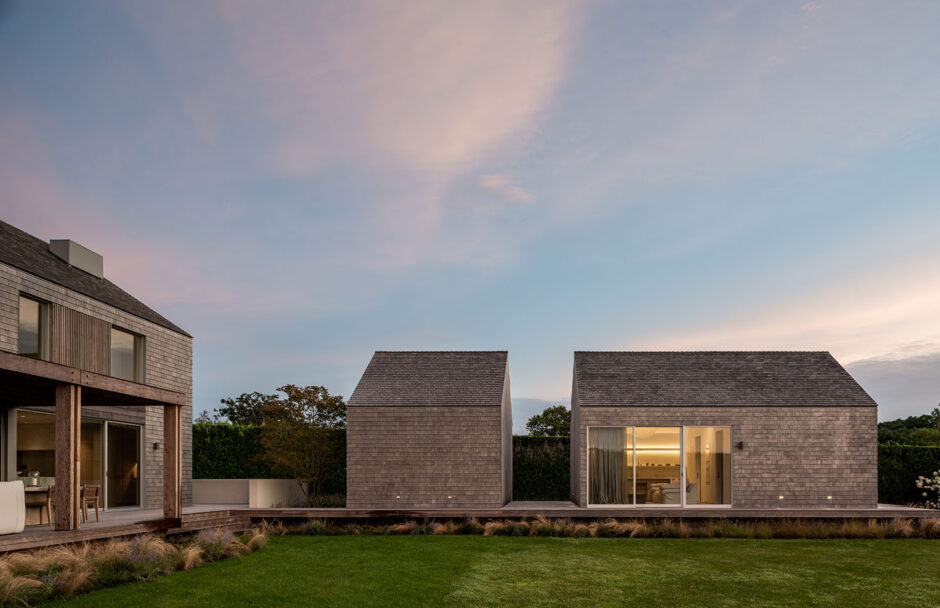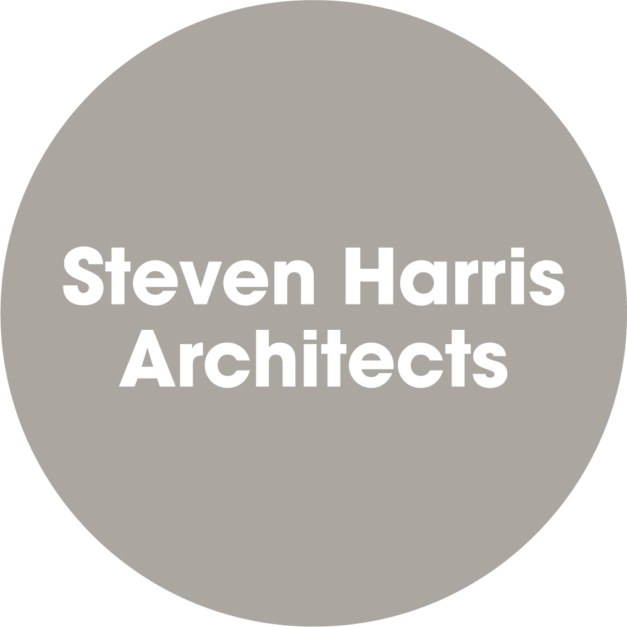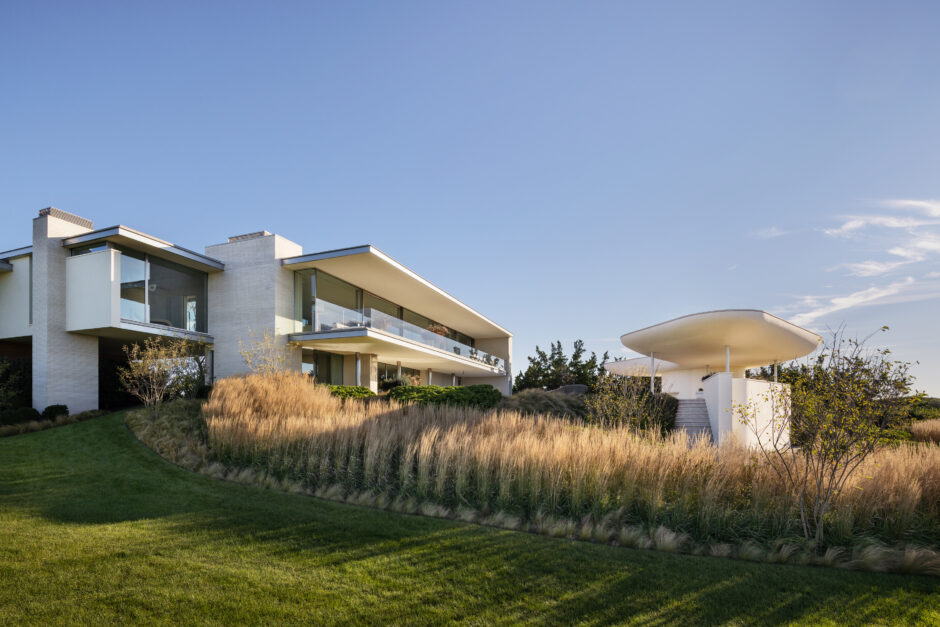~~~~~~~~~~~~~~~~~~~~~~~~~~~~~~~~~~~~~~
AIA Peconic
Daniel J. Rowen Memorial Design Awards / 2023
——— Awards Presented April 22, 2023 ———-
~~~~~~~~~~~~~~~~~~~~~~~~~~~~~~~~~~~
ARCHITECTURE HONOR AWARD 2023
Wainscott — Paul Masi AIA, Bates Masi + Architects LLC
———————
ARCHITECTURE MERIT AWARDS
- Jule Pond II — BMA Architects
- Signal Hill — Paul Masi AIA, Bates Masi + Architects LLC
- Mid Century Renovation — Robert Dean, Robert Dean Architects
- Butter Lane — Viola Rouhani AIA, Stelle Lomont Rouhani Architects
———————
ARCHITECTURE JUROR AWARDS
- Light House — Viola Rouhani AIA, Stelle Lomont Rouhani Architects
- Bridgehampton Beach House — Steven Harris, Steven Harris Architects LLP
- Bridgehampton House — Stuart Basseches AIA
———————
EMERGING ARCHITECTS MERIT AWARD
Hybrid Urban House — Ramona Albert AIA
———————
PROJECTS UNBUILT JUROR AWARDS
- Shore House — Nilay Oza AIA, Oza Sabbeth Architects
- Shelter in Place — Nilay Oza AIA, Oza Sabbeth Architects
———————
SUSTAINABLE ARCHITECTURE HONOR AWARD
Sheridan Green Residence — Christopher Jeffrey, Christopher Jeffrey ARCHITECTS PLLC
~~~~~~~~~~~~~~~~~~~~~~~~~~~~~~~~~~~~~~~~~~~~
Jurors for the Design Awards (Carlos Jiménez, Matthew Krissel, AIA, LEED AP, and Andrea Lamberti, AIA, LEED AP BD+C) and the special Jury adjudicating the Sustainable Architecture Award (Julie Janiski, Shivani Shah, LEED A, and Matt Wallace, AIA, LEED AP BD+C).
This is the inaugural year for the Sustainable Architecture Awards.
Juror Award — Recognizes excellence in resolving specific programmatic desires through interpretation of style, technologies, sustainability, materials, and/or vernacular influences. Juror awards are left up to the jury’s discretion and can awarded for any project in any category.
——————-
==================================
2023 Architecture Honor Award
——————
Wainscott
Paul Masi AIA / Bates Masi + Architects LLC

 At the end of the 19th Century a private beach community was established from over 100 acres of coastal farmland. Large specimen trees, winding roads, early colonial architecture, agricultural buildings, and views of a large pond and the Atlantic Ocean create a bucolic setting. The proximity to the pond and ocean, however, brings with it the challenges of high ground water and flood risk. It was here that a family with a passion for art decided to build a home for their family, including future generations, and their art collection. They requested it to become a family heirloom. As such the home must anticipate the family’s growth, providing space and privacy for guests, the couple’s adult children, and their future grandchildren. It must be durable. It must also be elevated in anticipation of the future flood risk while preserving a connection to the landscape. Finally, the home must provide large openings to take advantage of the sweeping views, and, at the same time, limit direct sunlight on the art.
At the end of the 19th Century a private beach community was established from over 100 acres of coastal farmland. Large specimen trees, winding roads, early colonial architecture, agricultural buildings, and views of a large pond and the Atlantic Ocean create a bucolic setting. The proximity to the pond and ocean, however, brings with it the challenges of high ground water and flood risk. It was here that a family with a passion for art decided to build a home for their family, including future generations, and their art collection. They requested it to become a family heirloom. As such the home must anticipate the family’s growth, providing space and privacy for guests, the couple’s adult children, and their future grandchildren. It must be durable. It must also be elevated in anticipation of the future flood risk while preserving a connection to the landscape. Finally, the home must provide large openings to take advantage of the sweeping views, and, at the same time, limit direct sunlight on the art.
In response, the house was divided into three separate gabled structures dedicated to the couple and the 2 future families of their children. Each volume has it’s own staircase to the unconnected 2nd floor spaces, which include bedrooms, lounge areas, laundry facilities, and kitchenettes. These separate self-sufficient volumes are connected on the main level by an art-filled circulation spine that opens to larger display spaces around the stairs. To provide indirect natural light, continuous clerestory windows along the spine allow diffused light from the north to filter through a carefully detailed exterior shingle screen. The openings modulate the light that enters, which is then reflected into the gallery space through oak ceiling coffers. The mechanical system is elevated above the spine to meet FEMA requirements and the supply and returns are concealed within the coffers. Artificial lighting is also integrated in the coffers, illuminating the art and backlighting the exterior screen. The continuous screen is a subtle change in the siding texture during the day, but highlighted when backlit at night, revealing on the exterior the continuous spine that unifies the individual volumes.
In each of the volumes, the stairwells double as larger art display areas and are naturally illuminated by northern light through bronze chimney light wells. The structure and cladding of each stair taper as they approach the floor, referencing the way light dissipates from the skylights above. The final art display area is the most dramatic: a day-lit glass cube that connects two of the gabled volumes to the third and serves as a sculpture gallery. A delicate cedar lattice wraps the glazing to filter the light and includes operable portions over sliding glass doors to allow for frequent rotation of the sculptures within. Lighting in this flexible space is mounted with magnets to allow for easy customization for each piece.
To ensure the home as an heirloom will endure, it is clad in durable materials that are applied in redundant layers. Cedar boards are installed like shingles in layers over a weathertight shell. Custom stainless clips hold the boards securely without penetrating them, allowing for them to expand and contract, or be easily replaced in the future.
The gallery spaces, circulation, lighting, and mechanical systems are interwoven into a spine that both ties the individual structures together, and symbolically ties the family together around their appreciation of art. The family will grow and change, as will their art, but the home will endure as a place of appreciation for both.
Credits & website link at end of portfolio.
——————————-
Juror Comments: “A remarkable work whose formal and material resolution is consistent and beautiful throughout. Each design element is given the same rigor of execution, care and thought. We appreciated the way in which the project references historic, local barn typologies while preserving a modern approach to the clear planning strategy and the construction and details.”
——————————-
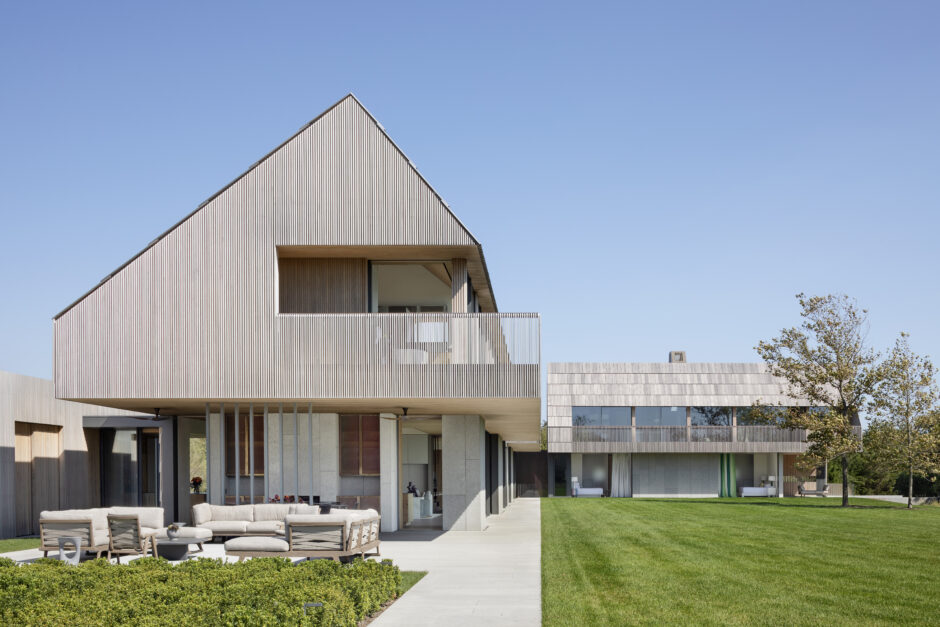
~~~~~~~~~~~~~~~~~~~~~~~~~~~~~~~~~~~~~~~~~~~~~~
Architecture Merit Award
——————
Jule Pond II
BMA Architects
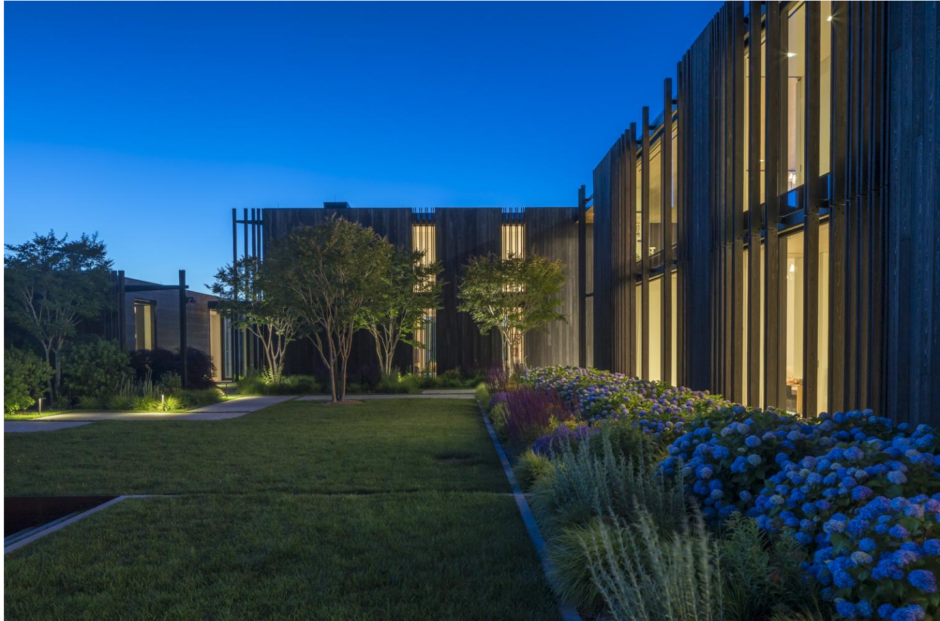
 Stone pavers meander through a courtyard lush with crepe myrtle and bayberry before arriving at the dramatic double-height glass entry to this home, which features a grand concrete staircase. The entry sets the tone for this unique project, where surprises beckon with every turn and design delivers larger-than-life living for a creative and active young family.
Stone pavers meander through a courtyard lush with crepe myrtle and bayberry before arriving at the dramatic double-height glass entry to this home, which features a grand concrete staircase. The entry sets the tone for this unique project, where surprises beckon with every turn and design delivers larger-than-life living for a creative and active young family.
Inspired by a sculpture within the landscape, this project expresses two distinct identities. At the entrance, a dark brise soleil spans two stories and presents a unified façade, visually connecting the three wings of the sprawling house, which were intentionally arranged to reduce the scale. The brise soleil opens and contracts the glazing in a rhythmic pattern, finally breaking free of the house itself and marching into the landscape. At the rear elevation, it becomes apparent that the house is in fact a wood volume clad in sun-bleached cedar and the brise soleil a shroud that distinguishes the front from the rear.
Within the house, the same motifs reappear. Stairs break free of walls, dark contrasts with light, millwork mimics the rhythm of the exterior brise soleil, and finishes carry from inside out. The result is a home that offers a spatially rich experience, nuanced in detail yet expressive in style.
Credits & website link at end of portfolio.
——————————-
Juror Comments: “One of the most striking elements in this design is the way that the exterior envelope is articulated to provide privacy and openness as needed. The discreet and elegant front gives way to a more open and expansive facade at the back of the house.
——————————-
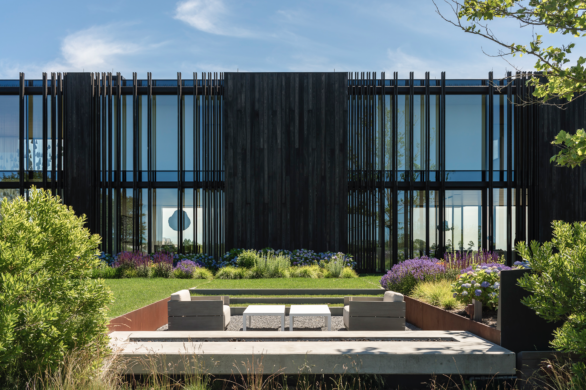
~~~~~~~~~~~~~~~~~~~~~~~~~~~~~~~~~~~~~~~~~~~~~~
Architecture Merit Award
——————
Signal Hill
Paul Masi AIA / Bates Masi + Architects LLC

 In the mid 17th century early settlers of Montauk, New York, established what is now the oldest working cattle ranch in America. Other ranches later emerged nearby and many remain but some have succumbed to residential subdivision. Their remnants survive today in the form of horse stables, barns, and workers’ cottages. One such cottage, a late addition built in the mid 20th century, sat near the top of a hill with almost 360 views of the nearby lake, ocean, sound, and nature preserves. Its new owners sought to maintain the existing structure’s unpretentious appearance and the pastoral landscape, while creating a larger house suiting the modern expectations of year-round living for a family of five.
In the mid 17th century early settlers of Montauk, New York, established what is now the oldest working cattle ranch in America. Other ranches later emerged nearby and many remain but some have succumbed to residential subdivision. Their remnants survive today in the form of horse stables, barns, and workers’ cottages. One such cottage, a late addition built in the mid 20th century, sat near the top of a hill with almost 360 views of the nearby lake, ocean, sound, and nature preserves. Its new owners sought to maintain the existing structure’s unpretentious appearance and the pastoral landscape, while creating a larger house suiting the modern expectations of year-round living for a family of five.
The house structure references traditional livestock pens built from glacial rubble that meander through the local landscape. Its stone walls extend to the top of the first floor, organizing its spaces and providing a base for the second story. The walls carve into the sloping meadow, reducing the apparent size of the home when viewed from the exterior. Some of the walls reach out and taper into the ground, cutting strategic sightlines into the hilltop and linking the house with the pool. These apertures brighten interior spaces, provide access to the lawns and meadows, and frame views of the lake and preserves. They carry from exterior, through the interior, and back to exterior. Cabinetry and built-ins abutting the stone walls are designed as freestanding pieces to further reinforce this continuity. Sliding glass walls disappear into recesses at the central sightline overlooking the lake, providing an uninterrupted connection between east and west, sunrise and sunset.
Perched atop the stone walls sit two simple shingled “cottages” reminiscent of the property’s original structures. Because the first floor is largely concealed they appear as small houses lightly set on the hill when viewed from the road and driveway approach below. Accessed by independent staircases, separated by a large roof deck, and rotated with respect to one another, their arrangement optimizes views for the bedrooms contained within. The northern volume aligns east-west with the children’s rooms overlooking the lake and sound. The southern volume aligns north-south, offering the master bedroom sweeping panoramas of the nature preserves, ocean, and lake. Unlike the traditional structures they recall, both volumes have vaulted ceilings belying their petite exteriors, deferring to their form, and befitting the house’s overall scale.
As the once small community has shifted from farming and fishing village to resort destination, the built environment that followed often arose with limited concern for history, scale, or sense of place. By engaging the hillside slope, focal points in the landscape, and traditional building types and materials, the design yields a house that truly feels at home, and literally grounded, in its surroundings.
Credits & website link at end of portfolio.
——————————-
Juror Comments: “A delightful and unexpected variation on the type. We appreciate the way the house is sited to maximize multiple views of the surrounding landscape. We also appreciate the use and interplay of timeless, complementary materials.”
——————————-
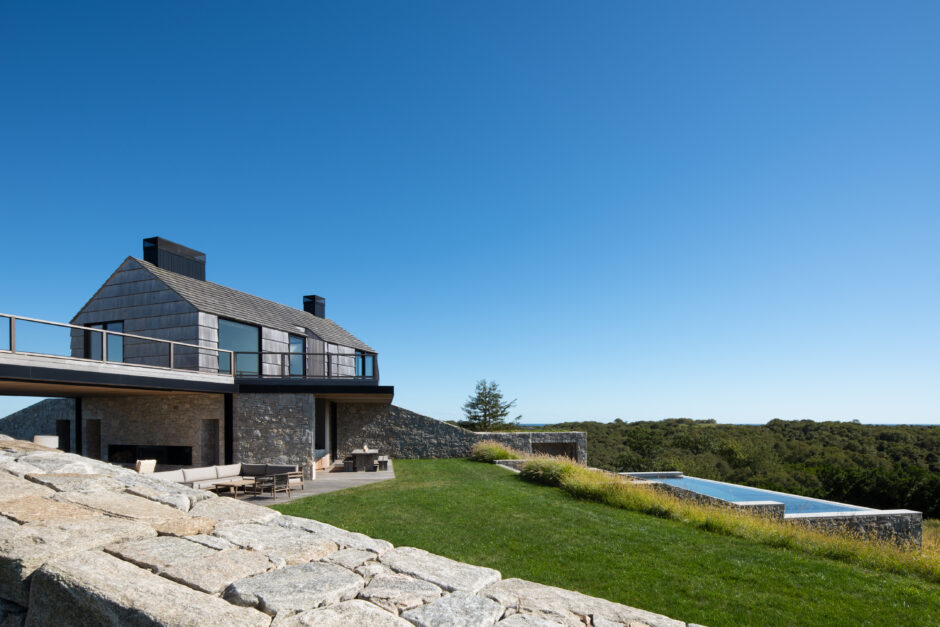
~~~~~~~~~~~~~~~~~~~~~~~~~~~~~~~~~~~~~~~~~~~~~~
Architecture Merit Award
——————
Mid Century Renovation
Robert Dean / Robert Dean Architects

 This project offered the opportunity to give new life to a distinguished “diamond in the rough” from East Hampton’s vibrant mid-century era, restoring and enlarging an early Harry Bates house. The house’s history also is closely associated with Howard Moss, a longtime summer resident of East Hampton and poetry editor for 40 years at The New Yorker Magazine. The house was in poor condition and was largely viewed as a tear-down, and we are proud of having saved it.
This project offered the opportunity to give new life to a distinguished “diamond in the rough” from East Hampton’s vibrant mid-century era, restoring and enlarging an early Harry Bates house. The house’s history also is closely associated with Howard Moss, a longtime summer resident of East Hampton and poetry editor for 40 years at The New Yorker Magazine. The house was in poor condition and was largely viewed as a tear-down, and we are proud of having saved it.
The house is typical of Bates’s work in that period, reflecting a slightly rustic form of contemporary coastal design with beautifully abstract forms executed in a simple palette of weathered wood and large glass areas. The house was designed as a single glass-box pavilion floating atop the site on a plinth of wood decking. Interior finishes were exceptionally simple with natural wood surfaces and exposed structure predominating.
Along with restoration we also needed to adapt the house to serve an active young family, and yet we were determined to give the original glass and wood pavilion pride of place, sustaining the simplicity of its siting. The house had seen only minor changes over the years – and had only about 1,250 sf of space. We enlarged the house to 2,250 sf by adding a second pavilion at the rear containing two bedrooms. Joining the two pavilions is a connecting structure that adds generous areas for dining and family activities.
A garage also was needed, and so we added this in the front yard in open tribute to Bates’s design themes in the original house. We reorganized the site, eliminating a rambling circular drive to permit the house, deck, and lawn to have their own uninterrupted dialogue. We also moved the swimming pool into the sunny part of the yard.
This house required a very large amount of restoration including replacement of all siding, roofing, deck surfaces, etc. We also replaced all glazing, and in the original structure we carefully worked new double-glazing into the existing wood openings. In new areas we used a modern glazing system, both for performance and in order to give separate expression to restoration areas vs. new-construction areas.
Within the restoration area, we reorganized the Kitchen and service spaces in order to enlarge the Kitchen and open it up to the new family interior and exterior spaces at the rear of the house. In doing this, we took care to sustain the clarity of the house’s original plan. Throughout the original pavilion we carefully worked new lighting, mechanical and shading systems, etc., into the existing finishes.
In the new spaces, we used finishes that were related to those of the original house but we did not seek to copy or extend the 60-year-old natural-wood surfaces that dominate the original interior. A new white oak floor with a light finish serves to brighten the dark wall and ceiling surfaces in the original rooms, and this floor extends into the new spaces to sustain continuity between old and new.
Credits & website link at end of portfolio.
——————————-
Juror Comments: We find this project exemplary in the respectful way that it undertook each aspect of its renovation. It learned from / and re-charged the original design to great effect, extending the life of the work, and serving as a relevant demonstration for taking inspiration to preserve an existing structure.
——————————-

~~~~~~~~~~~~~~~~~~~~~~~~~~~~~~~~~~~~~~~~~~~~~~
Architecture Merit Award
——————
Butter Lane
Viola Rouhani AIA / Stelle Lomont Rouhani Architects
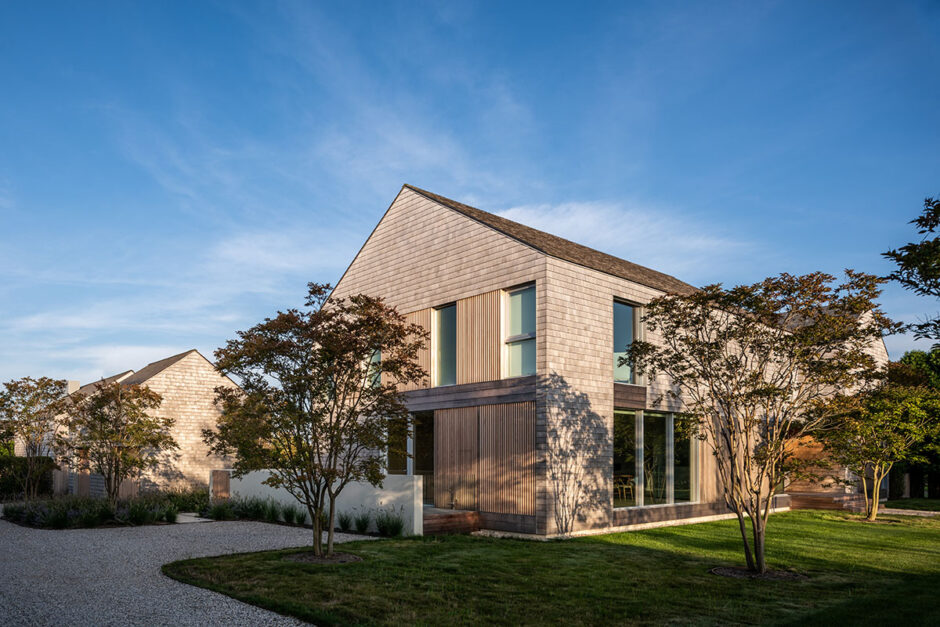
 A young couple, comprised of a builder starting out his solo career and his wife, an interior curator with her own business, approached us to design their new house. The house was to replace their current one, an old barn type structure that had been modified and changed over the years, but lacked light and space for their soon to be growing family.
A young couple, comprised of a builder starting out his solo career and his wife, an interior curator with her own business, approached us to design their new house. The house was to replace their current one, an old barn type structure that had been modified and changed over the years, but lacked light and space for their soon to be growing family.
The main house, pulled away from the street, is broken up into two volumes that reflect the barn like structures of the past, both in shape and in finish, with wood shingles wrapping the walls and the roof. Meant to weather, the shingles will turn grey and feathery over time. The main house overlooks the large working farm across the street. In back, a separate garage and pool house create a buffer from the school next door while hugging the site, a playful open area with a new pool.
Detailing and the material palette are intentionally minimal, allowing the spaces inside to soar and take center stage. Emphasis is placed on the path of the sun throughout the day, with window placement allowing for a constant show of light, grounding the house in time of day.
Credits & website link at end of portfolio.
——————————-
Juror Comments: “We very much like the subtle simplicity that courses through the serenity of this work. A quiet, refined work with a similar set of proportions maintained across multiple structures, daylight is carefully controlled as it penetrates the clean interior spaces.”
——————————-
~~~~~~~~~~~~~~~~~~~~~~~~~~~~~~~~~~~~~~~~~~~~~~
Architecture Juror Award
——————
Light House
Viola Rouhani AIA / Stelle Lomont Rouhani Architects

 The quest here was to create a house on a stunning bluff overlooking the water that invoked a sense of drama without competing with the site itself. A program consisting of just three bedrooms, but ample communal space, and areas for art or dance gave us an opportunity to play with scale and proportion resulting in a pavilion like structure.
The quest here was to create a house on a stunning bluff overlooking the water that invoked a sense of drama without competing with the site itself. A program consisting of just three bedrooms, but ample communal space, and areas for art or dance gave us an opportunity to play with scale and proportion resulting in a pavilion like structure.
Spaces happen at the intersection of walls and planes, extending out to bring the landscape in. The main living area has three levels, with lounging and eating at terrace level, kitchen, slightly elevated as central command, and a neat mezzanine a few steps up, like a hidden nest, still in full communication with the other spaces. Art prevails throughout the house, with the interiors conceived from the start and fully integrated with the architecture.
A walk out basement allows for darkness, where needed in a generous cinema, and light for the creations of art and dance. Mindful of not giving everything away at once, the hide and the reveal is accomplished through the approach of the house with of a series of walls. Each turn leading to the front door reveals a different view and perspective.
Credits & website link at end of portfolio.
——————————-
Juror Comments:“The beautiful exterior composition is complimented by the careful integration of art throughout, adding a layer of richness and specificity to the interiors. We appreciated also the minimalist approach to interior details and treatment of finishes, and noted how the simple and bold building forms allow for year-round appreciation of landscape, gardens and living spaces.”
——————————-

~~~~~~~~~~~~~~~~~~~~~~~~~~~~~~~~~~~~~~~~~~~~~~
Architecture Juror Award
——————
Bridgehampton Beach House
Steven Harris / Steven Harris Architects LLP
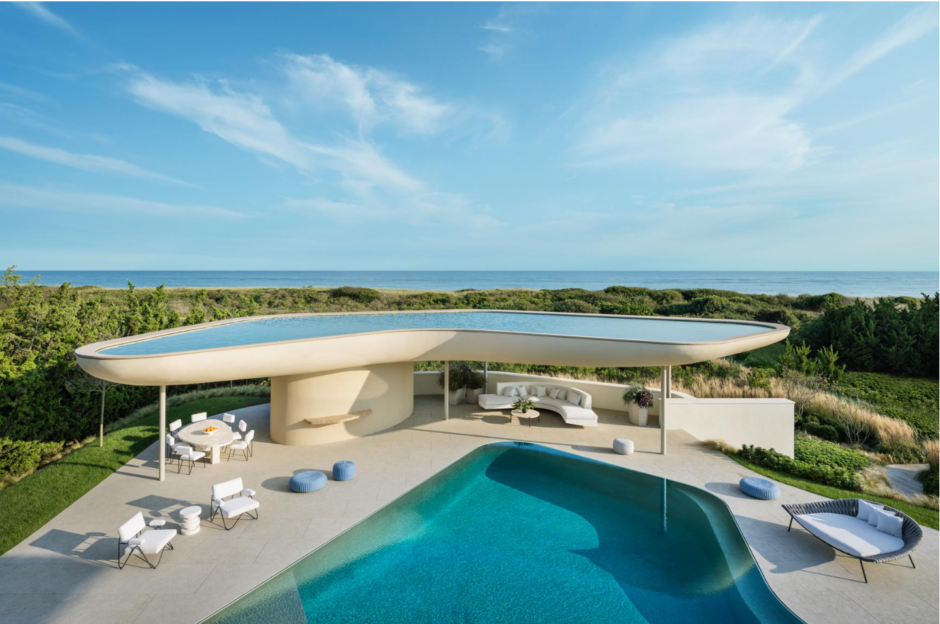
The clients desired architecture in the midcentury modern tradition that showcased the dune-filled landscape and created space to enjoy time with friends and family. The resulting house features sculptural forms and sweeping vistas, and blends high art with everyday life.
Achieving this involved integrating art and views into quotidian moments. Entering off the parking court, guests are greeted by a sculpted cast-concrete mural. In the central courtyard, another mural covers the wall next to the main entrance. Dynamic second floor volumes cantilever around the courtyard to create areas of shelter and direct the eye towards the pool deck and landscape beyond.
The home’s entrance hall doubles as a stair hall and gallery. There, floor-to-ceiling glass windows provide an uninterrupted view of the home’s curving knife-edge pool and cabana. A mural covers one wall, which in turn extends through the glass and creates the impression that the art is part of the building’s structure….Textured Grigio Olivo stone floors unite the central courtyard, interior, and pool pavilion, creating the impression of a continuous floor plane.
The entry hall’s teak-clad central staircase intersects with the window wall, slipping outside before opening upstairs onto a continuous room containing theme’s kitchen, breakfast, dining, and living areas…Floor to ceiling windows extend the room’s length, granting a panoramic vista over the site’s tall dunes towards the Atlantic Ocean. The home is elevated above the flood plane, making this view possible. A reflecting pool crowns the pool pavilion’s sculptural canopy, mimicking and enhancing the water view beyond….
On the opposite side of the house, a sculptural twelve-by-six-foot door opens onto a sun-drenched hallway with full-width ribbon windows overlooking the central courtyard.
Credits & website link at end of portfolio.
——————————-
Juror Comments: By animating views within and beyond the building through integration of art, curvilinear forms and water features, the project is unabashed in its playful approach to creating a residential plinth atop the site’s hill crest.
——————————-
~~~~~~~~~~~~~~~~~~~~~~~~~~~~~~~~~~~~~~~~~~~~~~
Architecture Juror Award
——————
Bridgehampton House
Stuart Basseches, AIA
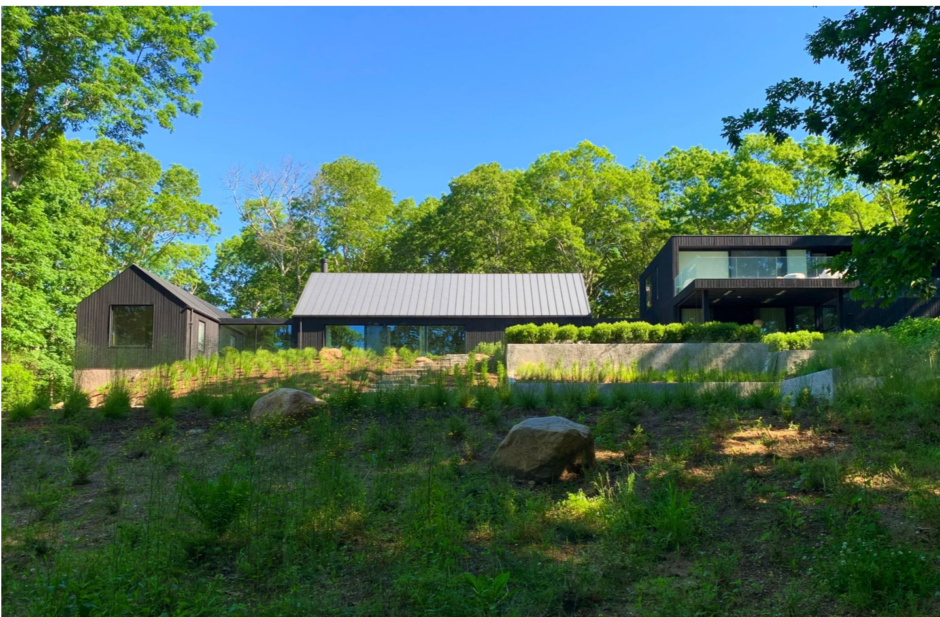
 The client, the second owners of the original house, had been using it as a weekend home for a decade prior to calling. Their hope was to transform the house into one that better suited their needs while updating its appearance and function.
The client, the second owners of the original house, had been using it as a weekend home for a decade prior to calling. Their hope was to transform the house into one that better suited their needs while updating its appearance and function. Juror Comments:This work achieves a complementary, unified transformation of two discordant existing structures. Its economical detailing, and modest attitude further enriches this discrete integration. We admire the intent to preserve and extend the existing building.
——————————-

~~~~~~~~~~~~~~~~~~~~~~~~~~~~~~~~~~~~~~~~~~~~~~
Emerging Architects Merit Award
——————
Hybrid Urban House
Ramona Albert AIA
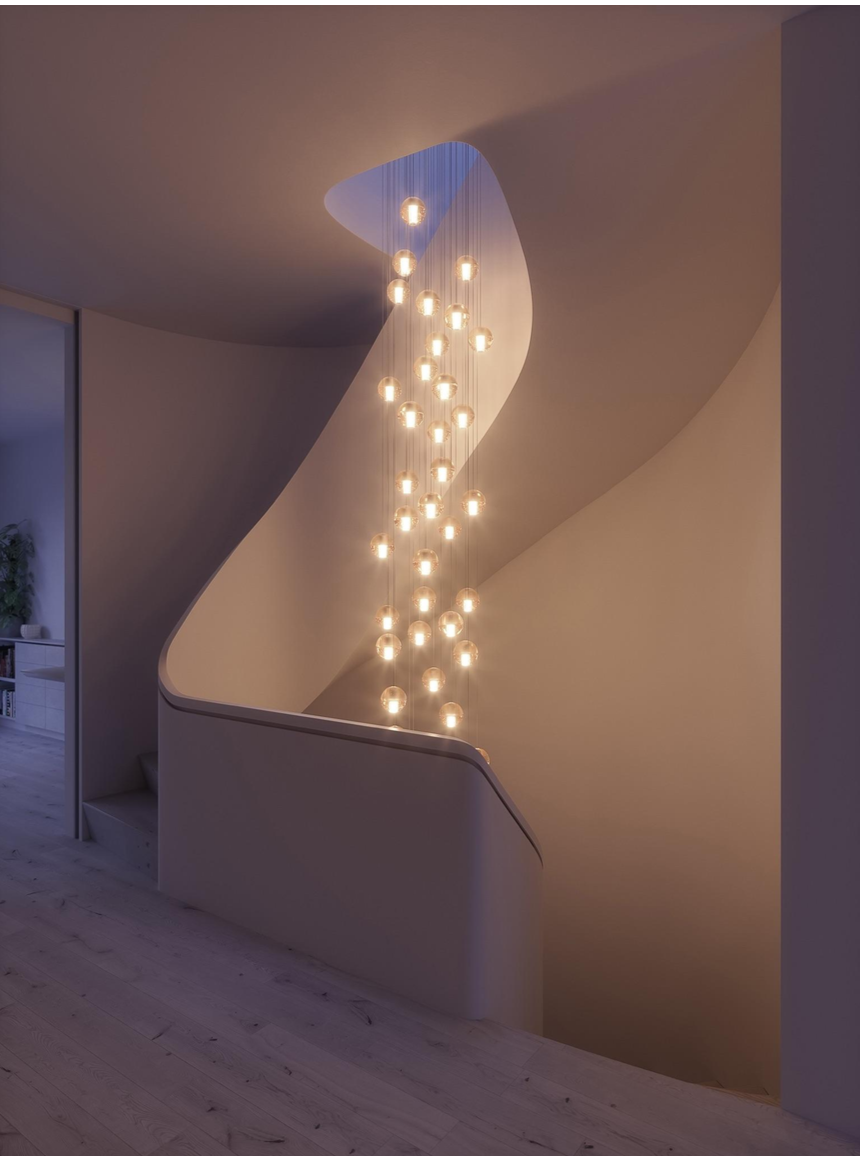
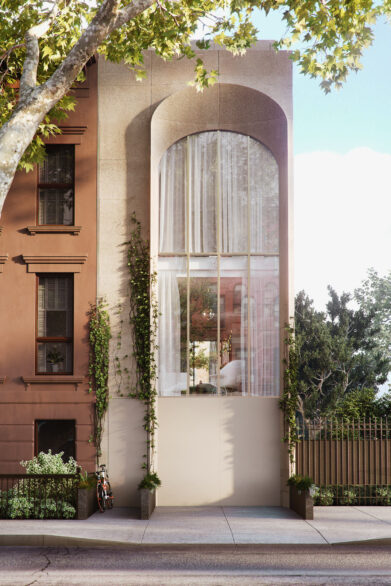
 The project is a new townhouse in Brooklyn. It is a single family residence – on a street lined with carriage houses. The facade is meant to mimic the existing arches of the carriage houses on the street. The lower level has a garage while the top two floors are the living areas
The project is a new townhouse in Brooklyn. It is a single family residence – on a street lined with carriage houses. The facade is meant to mimic the existing arches of the carriage houses on the street. The lower level has a garage while the top two floors are the living areasCredits & website link at end of portfolio.
——————————-
Juror Comments: A sophisticated, elegant design, best captured in the promise of its exquisite renderings. Restraint marries exuberance as the streamlined material surfaces come into contact with occupants as they engage the bath, vertical circulation and portals into the delicate interior.
——————————-
~~~~~~~~~~~~~~~~~~~~~~~~~~~~~~~~~~~~~~~~~~~~~~
Projects Unbuilt Juror Award
——————
Amagansett Shore House
Nilay Oza AIA/ Oza Sabbeth Architects


This proposed beach house is located in Amagansett. Conceived as a split-level residence that works in tandem with the site’s topography, the goals of the project are two-fold: to create a beautiful dwelling that maximizes the view of the ocean and to use its substructure as a means of reducing the coastal erosion of the dunescape.
The composition and materiality of the building harkens to the mid-century Fire Island sensibility of clean lines and simple forms that direct views towards the ocean. These simple forms step up with the landscape in order to grant the kitchen, dining and living areas access to the pool deck, the bluff and the water beyond. The master suite sits on top of the living/dining area and is rotated away from the neighboring resort to enhance privacy and allow for an unobstructed view of the ocean.
The structure of the building is then used to preserve the dune crest with the positioning of the building plan along the dune’s contour line. A pile and lagging system reinforces the sandy terrain, and by tying it to the structure of the house, bolsters the integrity of the dune itself. The support of excavation sequence works not only to facilitate a safe and efficient space for construction, but it doubles as a permanent structural bulwark against site erosion.
Credits & website link at end of portfolio.
——————————-
Juror Comments: The explorations of form, shaped by light and view, create a thoughtful response to the site’s unique features. We remarked upon the ease with which we can understand the clarity of the design approach that links the site plan considerations to the building’s orientation toward ocean views from the upper level.
——————————-

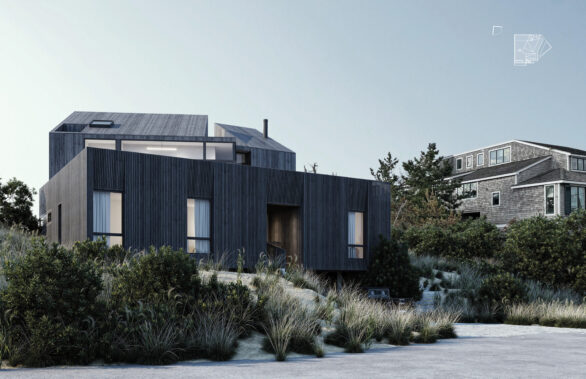
~~~~~~~~~~~~~~~~~~~~~~~~~~~~~~~~~~~~~~~~~~~~~~
Projects Unbuilt Juror Award
——————
Shelter in Place
Nilay Oza AIA/ Oza Sabbeth Architects

 This project was an immediate casualty of the covid pandemic. As the world seemed less stable, this project evolved into an internal design exercise to keep the team’s mind off the unknown. Unsurprisingly, everyone’s preoccupation – the unknown quality of the pandemic-impressed itself upon this design in turn. Slowly but surely, this design took on a more forbidding quality.
This project was an immediate casualty of the covid pandemic. As the world seemed less stable, this project evolved into an internal design exercise to keep the team’s mind off the unknown. Unsurprisingly, everyone’s preoccupation – the unknown quality of the pandemic-impressed itself upon this design in turn. Slowly but surely, this design took on a more forbidding quality.
As we found, the beach retreat’s cheery resonance took on a darker edge. The design exercise stopped being about a particular house designed for a specific place and time. It became a stand-in for the quintessential beach house and a story of how it changes over time in a blight-altered world.
Finishes end construction and weathering constructs finish*. — We try and abide by this mandate in our practice. To study this weathering, we undertook multiple versions of the rendering. We studied aging, neglect, and deterioration as an extreme process – the material choice changed.
The main volume, which started as wood, became a sizeable concrete shroud that peels off the ground floating the house above the horizon. Scavenged as if from an industrial landscape and set amidst the bay, the home could be more conventionally inviting. Towards this bay, the concrete shell and the house open up, offering shelter and prospect.
*On Weathering, Mostafavi’ 93.
Credits & website link at end of portfolio.
——————————-
Juror Comments: A bold, tectonic gesture that protects from / and opens to the seascape. We appreciated the raw, tough shell of the exterior countered by its soft and warm interior. In lifting the living spaces to capture views and shelter the entrance, the concrete form also unifies functions and imparts privacy for the interior.
——————————-
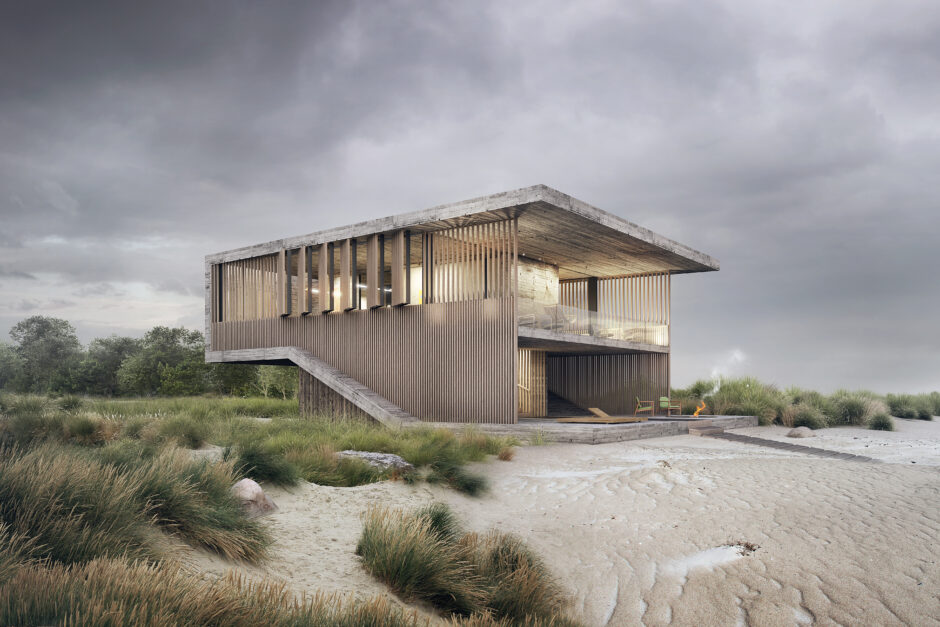
~~~~~~~~~~~~~~~~~~~~~~~~~~~~~~~~~~~~~~~~~~~~~~
Sustainable Architecture Honor Award
——————
Sheridan Green Residence
Christopher Jeffrey / Architects PLLC
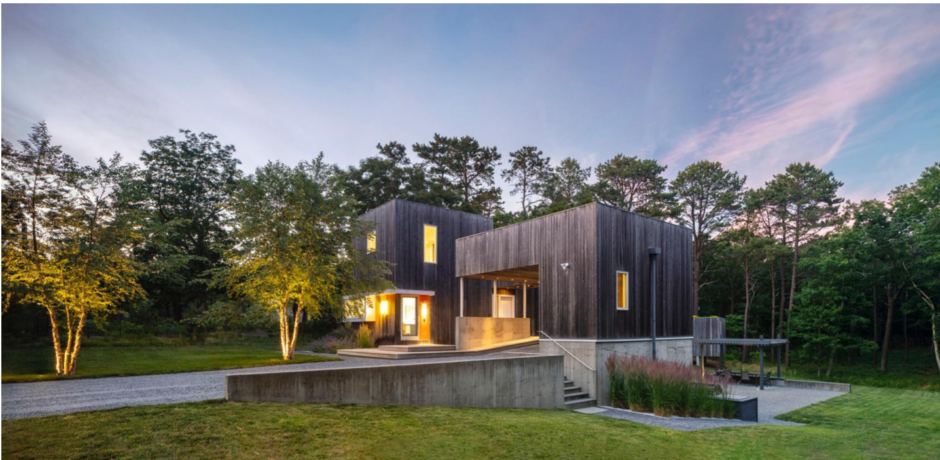

Your property, your energy, your choice! Sheridan Green is a residence for the modern homesteader who believes that sustainable solutions provide a closer relationship with our environment. The 1-acre wooded property had limited infrastructure and provided the perfect setting to develop a house that embraced its surroundings and create a self-sustaining residence. Located on a private gravel road, the 3-bedroom house is 1,966 htd.sq.ft. and built into the sloping site. Red cedar t&g clad volumes and sit on concrete walls that are set orthogonal with the cardinal axis on the property.
Sustainable design concepts:
Energy systems:
– passive & active solar
– ground sourced geothermal/heat pump forced air system with erv.
A hybrid energy system combines contemporary technologies with the opportunities of passive design to produce and reduce energy. South facing windows expose the concrete surfaces to absorb the winter sun and radiate cooling using the grounds thermal effects seasonally. Open loop geothermal wells run a 3-zone heat-pump hvac system. A tall central “convection” space combines the circulation effects of an attic ERV with the radiant slab at grade level to distribute the air evenly thru the house. An 8kw pv array provides most of the electricity for the house. This system maintains an average monthly electrical cost of $120.00. Propane supplies the cooktop and a 20kw generator.
Gardens and vegetation:
Gardening is an interactive experience that demands attention and cultivation which provides sustenance and beauty to a sustainable lifestyle. A rolling lawn composed of Earth-turf seed mixture combines drought tolerant fescue grasses with micro-clover to maintain density/nitrogen levels. A vegetable garden on the carport roof is composed of 2 raised beds and filled with a lightweight vermiculite/organic soil mixture. Courtyard contains herb/flower gardens, and 3 espalier pear trees trellised off the concrete ties. Sedum roofs on the yoga studio and bedroom porch to provide a seasonally changing color palette.
Well-being:
A sound mind and body are critical to heathy lifestyle and maintaining a “sustainable” fitness. The elevated Yoga Studio at the rear of the property sits on 2 concrete walls and is a place to retreat and re-energize. The space allows for many different physical activities with 4 – 1000w infra-red heating panels to radiant heat up to 120 degrees.
Credits & website link at end of portfolio.
——————————-
Juror Comments: We applaud the high-performance, nearly all-electric systems coupled with robust envelope design and on-site renewables. The holistic approach to sustainability with focus on energy efficiency, native landscaping, and well-being is commendable. There’s no doubt that would be an incredible living experience for the occupants in addition to a sustainable approach to material and resource use.
——————————-
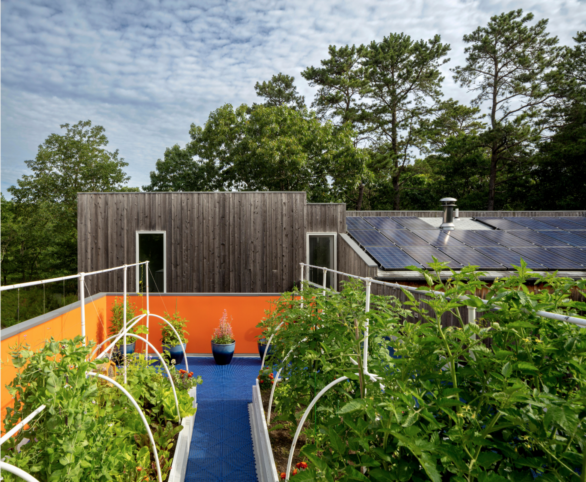
Photos: Paul Warchol Photography
_________________________________
~~~~~~~~~~~~~~~~~~~~~~~~~~~~~~~~~~~~~~~~~~~

~~~~~~~~~~~~~~~~~~~~~~
ARCHITECTURE HONOR AWARD 2023
Wainscott — Paul Masi AIA, Bates Masi + Architects LLC
ARCHITECTURE MERIT AWARDS
- Jule Pond II — BMA Architects
- Signal Hill — Paul Masi AIA, Bates Masi + Architects LLC
- Mid Century Renovation — Robert Dean, Robert Dean Architects
- Butter Lane — Viola Rouhani AIA, Stelle Lomont Rouhani Architects
ARCHITECTURE JUROR AWARDS
- Light House — Viola Rouhani AIA, Stelle Lomont Rouhani Architects
- Bridgehampton Beach House — Steven Harris, Steven Harris Architects LLP
- Bridgehampton House — Stuart Basseches AIA
EMERGING ARCHITECTS MERIT AWARDHybrid Urban House — Ramona Albert AIA
PROJECTS UNBUILT JUROR AWARDS
- Shore House — Nilay Oza AIA, Oza Sabbeth Architects
- Shelter in Place — Nilay Oza AIA, Oza Sabbeth Architects
SUSTAINABLE ARCHITECTURE HONOR AWARD
Sheridan Green Residence — Christopher Jeffrey, Christopher Jeffrey ARCHITECTS PLLC
——————————
========================================
———————————— CREDITS ————————————
AIA Peconic — Project / Architect /Project Team
————————–
2023 Architecture Honor Award
 Wainscott / Bates Masi + Architects
Wainscott / Bates Masi + Architects
2023 Architecture Merit Award
Jule Pond II / BMA Architects
—————————
2023 Architecture Merit Award
 Signal Hill / Bates Masi + Architects
Signal Hill / Bates Masi + Architects
Architect: Paul Masi, AIA, LEED AP — lead design partner; Project Team: Aaron Zalneraitis, James Willis. Contractor: Merit Builder. Sub-contractor: Steven Maresca, Structural Engineer. Interior Designer: Chused & Company. Landscape Architect: LaGuardia Design Group.
2023 Architecture Merit Award
Mid Century Renovation / Robert Dean / Robert Dean Architects
Project Team: Architecture and Interior Design: Robert Dean Architects; Landscape Design: Geoffrey Nimmer Landscapes; Contractor, Alex Garcia; Photographer, Neil Landino.
—————————
2023 Architecture Merit Award
 Butter Lane / Viola Rouhani AIA / Stelle Lomont Rouhani Architects
Butter Lane / Viola Rouhani AIA / Stelle Lomont Rouhani Architects
Project Architect and Team: Viola Rouhani- Architect – Damen Hamilton and Joseph D’Arco Project Manager and Designer. Contractor: Bocchino Theisen Builders. Interior Designer: Michael Del Piero. Landscape Architect: LaGuardia Design Group
![]()
—————————
2023 Architecture Juror Award
 Light House / Viola Rouhani AIA / Stelle Lomont Rouhani Architects
Light House / Viola Rouhani AIA / Stelle Lomont Rouhani Architects
Project Architect and Team: Viola Rouhani- Architect – Damen Hamilton and Joseph D’Arco Project Manager and Designer. Contractor: Bocchino Theisen Builders. Interior Designer: Michael Del Piero. Landscape Architect: LaGuardia Design Group.
2023 Architecture Juror Award
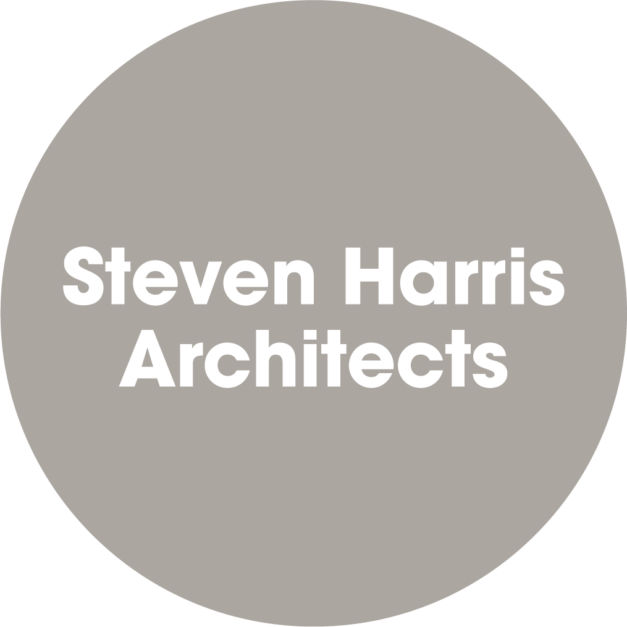 Bridgehampton Beach House / Steven Harris, Architect
Bridgehampton Beach House / Steven Harris, Architect
Project Team: Steven Harris, Steven Harris Architects LLP. Interior Design: Rees Roberts & Partners; Landscape Design: Rees Roberts & Partners; Contractor: Bulgin and Associates ; windows are by Reilly Architectural; swimming pool by J. Tortorella; and landscape contracting by Summerhill landscapes.
————————————————–
2023 Architecture Juror Award
Bridgehampton House — Bass Architect
Project Team, Stuart Basseches, Konstantinos Spiropoulos; Interior Design, Valerie Pasquiou Interiors; Lighting, Luciforma; Landscape Design, Michelle Madonna; Contractor, Keith Flynn, Shore Woodworks.
————————————————–
2023 Emerging Architects Merit Award
Hybrid Urban House— Ramona Albert AIA
————————————————–
2023 Projects Unbuilt Juror Award
Shelter in Place / Nilay Oza AIA/ Oza Sabbeth Architects
————————————————–
2023 Projects Unbuilt Juror Award
Amagansett Shore House / Nilay Oza AIA/ Oza Sabbeth Architects
• Bronze medal EPA Energy Star Certified New Home
• HERS Score 97/ Index 15/5 stars plus confirmed/ 85% better comparison. • Air Changes/Infiltration rate: heating/cooling 1136, CFM50
• Duct leakage to outside: 3.00 CFM25
Building materials:
• Foundation: poured concrete walls w/ R-10 board insulation/waterproofing/stucco exterior. • Insulation: R-25 exterior walls, R-38 ceiling, R-10 slab/concrete walls.
• Floors: hydronic radiant concrete, recycled cork flooring at upper levels.
• Siding: natural t&g western red cedar on ZIP-system sheathing w/ Blue-skin building wrap.
• Roofing: white 90 mil. EPDM, 40-year asphalt shingles at PV array.
• Door/Windows: Andersen 400 series, Low-E4 SmartSun, U-value 0.26, SHGC 0.23. • HVAC: ground sourced geothermal wells w/ forced air heat pump system/ERV • 8kw Photovoltaic Array
• Non-voc paints & finishes.
• Lighting/Appliances – LED & energy star rated.
———————————————–

________________________________________


